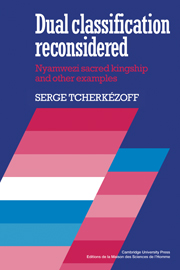1 - Right/Left oppositions and the ‘pre-eminence of the right hand’
Published online by Cambridge University Press: 04 August 2010
Summary
The opposition between the categories of ‘right’ and ‘left’ is a familiar and quasi-universal feature of the ‘symbolic’ classifications of human societies. A given object, depending upon its nature, is placed upon the right or left of a house. A human being, depending upon whether he or she is a man or a woman, is buried lying on his or her right or left side. A different status is accorded to the places on the right and left of the master of ceremonies or host at feasts and banquets. Still more generally, people take care not to confuse the gestures which should be carried out with the right hand with those which involve the left hand. There is, for example, an opposition between amorous caresses and bodily hygiene or, in the case of our own customs, one can distinguish between a respectful greeting, where one invariably uses the right hand, and a friendly wave, where either hand may be used.
Oppositions of this kind were already being studied in the late nineteenth century, and scholars were mainly concerned to account for the special value accorded the right hand. Research was not, however, concerned with the social aspects of this one-sided attribution of value. It aimed, rather, to add further refinements to natural explanation. Thus, in accord with Professor Broca's findings, an asymmetrical development of the nervous centres was held to render the greater skill of the right side inevitable: ‘We are right-handed because we are left-brained’ (Hertz 1960, p.90).
- Type
- Chapter
- Information
- Dual Classification ReconsideredNyamwezi Sacred Kingship and Other Examples, pp. 3 - 26Publisher: Cambridge University PressPrint publication year: 1987

